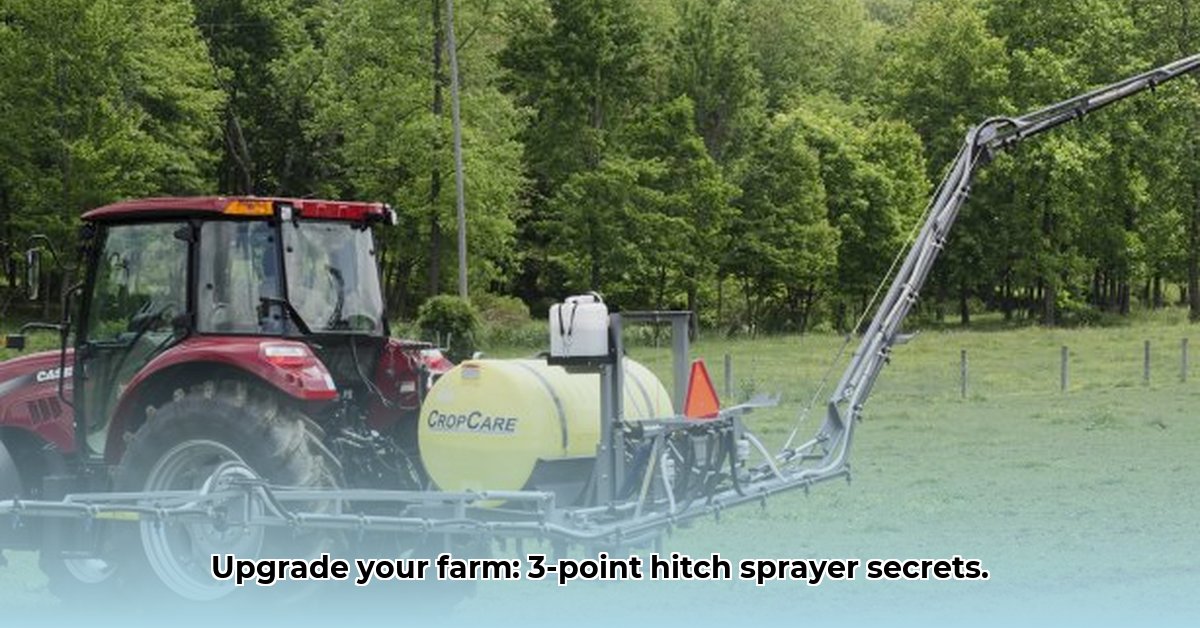
Choosing the right 3-point hitch sprayer is crucial for efficient and sustainable farming. This guide provides a comprehensive overview of selecting, operating, and maintaining these vital tools, emphasizing environmentally responsible practices. Learn more about tractor 3-point hitches here.
Understanding 3-Point Hitch Sprayers
A 3-point hitch sprayer (a chemical applicator attached to your tractor's 3-point hitch) simplifies chemical application, leveraging your tractor's power. However, various types exist, each with unique advantages and disadvantages impacting efficiency and environmental impact. Key considerations include tank size, pump type, and boom length. Larger tanks reduce refill trips, but add weight and require a more powerful tractor. Pump types include PTO (Power Take-Off, directly powered by the tractor) and electric (quieter and more fuel-efficient, but potentially less powerful). Boom length determines coverage per pass; longer booms are better for larger fields but can be less maneuverable.
Selecting the Perfect Sprayer: A Step-by-Step Guide
Choosing the right sprayer requires careful consideration of your specific needs and budget. Follow these steps:
Assess Your Needs: Consider farm size (acres), crop types, budget, and desired automation level (e.g., automatic boom height control, GPS guidance). Larger farms benefit from larger tanks and longer booms, while smaller farms might find simpler models sufficient.
Determine Tank Capacity: Match tank size to field size. Larger tanks reduce refill time but increase weight and cost.
Choose Your Pump Type: PTO pumps offer superior power for larger sprayers and thicker chemicals, but consume more fuel. Electric pumps are quieter, more fuel-efficient, and environmentally friendly, but may lack power for demanding tasks. Which option best suits your needs and minimizes your environmental footprint?
Select the Right Boom Length: Boom length directly impacts coverage per pass. Longer booms improve efficiency in large fields, but maneuverability decreases, especially in tight spaces or around obstacles.
Consider Nozzle Type and Pattern: Nozzle selection is critical for even application and minimizing drift. Low-drift nozzles are recommended to reduce environmental impact. Different nozzle types (e.g., flat fan, cone) are suited for various crops and conditions.
Operating Your Sprayer Efficiently and Safely
Efficient and safe operation is paramount. Prioritize these key aspects:
Calibration: Accurate calibration is essential for precise chemical application, preventing waste and maximizing efficacy. Incorrect calibration can lead to uneven application and potentially damage crops.
Application Techniques: Maintain consistent boom height and overlap between passes to ensure uniform coverage. Avoid spraying during windy conditions to minimize drift. Remember, drift leads to wasted chemicals and potential environmental contamination.
Regular Maintenance: Regularly inspect hoses, nozzles, and other components for wear and tear. Clean the sprayer thoroughly after each use to prevent clogging and ensure longevity. Proactive maintenance prevents costly breakdowns and ensures optimal performance.
Sustainability: Minimizing Environmental Impact
Sustainable practices are essential. Implement these strategies:
Minimize Drift: Use low-drift nozzles and avoid spraying in windy conditions. Drift leads to wasted chemicals, potentially contaminating nearby areas and harming the environment.
Reduce Chemical Usage: Precise calibration and application minimize waste. Consider transitioning to environmentally friendly, biodegradable alternatives when possible.
Safe Chemical Handling, Storage, and Disposal: Always follow local and national regulations for chemical handling, storage, and disposal. This protects the environment and ensures your safety.
Comparing Pump Types: PTO vs. Electric
| Feature | PTO-Driven Pump | Electric Pump |
|---|---|---|
| Power | High; suitable for larger sprayers & thicker fluids | Lower; best for smaller sprayers & less viscous fluids |
| Fuel Efficiency | Lower; uses tractor fuel | Higher; more environmentally friendly |
| Maintenance | More frequent; more complex | Less frequent; generally simpler |
| Noise Level | Higher | Lower |
| Cost | Typically higher initial investment | Typically lower initial investment |
| Environmental Impact | Higher due to fuel consumption | Lower due to reduced emissions |
Regulatory Compliance: Knowing the Rules
Always comply with local and national regulations concerning pesticide use and disposal. Failure to comply can result in penalties. Regularly review relevant legislation to ensure you're operating within the law.
Tips for Sustainable Spraying Success
- Regular maintenance extends sprayer life and ensures consistent application. Neglecting maintenance leads to avoidable expenses and reduced efficiency.
- Precision agriculture technologies (GPS guidance, variable-rate application) further optimize chemical use and minimize environmental impacts. These technologies offer substantial potential for cost savings and environmental benefits.
- Stay informed on best practices and regulatory changes for responsible chemical application.
Responsible chemical application is crucial for sustainable and effective farming. By choosing the right 3-point hitch sprayer and employing sound operational practices, farmers can significantly reduce environmental impact and improve efficiency.